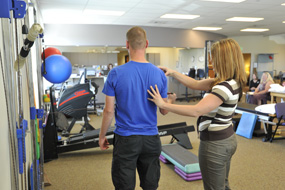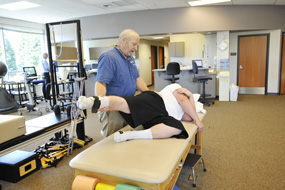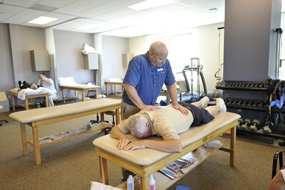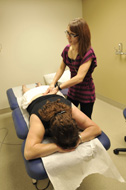Back & Neck Pain
Overview
 Back strain is a fairly broad category called “soft tissue injury,” which covers muscles, tendons and ligaments. About 80% of back and neck pain is muscle-related.
Back strain is a fairly broad category called “soft tissue injury,” which covers muscles, tendons and ligaments. About 80% of back and neck pain is muscle-related.
The stomach muscles, or abdominals, enable the back to bend forward. They also assist in lifting. The abdominals work with the buttock muscles to support the spine. The oblique muscles go around the side of the body to provide additional support to the spine.
Another type of strain relates to spinal ligaments that run in front and in back of the vertebral bodies. Tendons, which also connect muscles in the spine, can develop inflammation, or tendonitis.
Some people believe that part of what makes the back muscles more prone to strain is that they are shorter than other big muscles in the body. The muscles in our thighs that enable us to walk, run and jump are longer and less prone to strain. It’s very unusual to strain a thigh muscle.
Causes
 Muscles in the back can strain or spasm and form a hard lump, like a charley horse in the leg. Back muscle spasms can be caused by injury and pain, whether the source is muscle strain, or a disc problem. A spasm, defined as an involuntary convulsive contraction of muscle fibers, can be excruciating. The muscle spasm can be steady or come in waves of contractions. Your muscle is sending you a signal that it has been pushed beyond its ability.
Muscles in the back can strain or spasm and form a hard lump, like a charley horse in the leg. Back muscle spasms can be caused by injury and pain, whether the source is muscle strain, or a disc problem. A spasm, defined as an involuntary convulsive contraction of muscle fibers, can be excruciating. The muscle spasm can be steady or come in waves of contractions. Your muscle is sending you a signal that it has been pushed beyond its ability.
[top]
Symptoms
A symptom of muscle strain may be an excruciating spasm in the back that is very painful.
Diagnosis
Outlined below are some of the diagnostic tools that your physician may use to gain insight into your condition and determine the best treatment plan for your condition.
Medical history: Conducting a detailed medical history helps the doctor better understand the possible causes of your back and neck pain which can help outline the most appropriate treatment.
Physical exam: During the physical exam, your physician will try to pinpoint the source of pain. Simple tests for flexibility and muscle strength may also be conducted.
X-rays are usually the first step in diagnostic testing methods. X-rays show bones and the space between bones, however, they do not show muscles and ligaments.
MRI (magnetic resonance imaging) uses a magnetic field and radio waves to generate highly detailed pictures of the inside of your body. Since X-rays only show bones, MRIs are needed to visualize soft tissues like discs in the spine. This type of imaging is very safe and usually pain-free.
CT scan/myelogram: A CT scan is similar to an MRI in that it provides diagnostic information about the internal structures of the spine. A myelogram is used to diagnose a bulging disc, tumor, or changes in the bones surrounding the spinal cord or nerves. A local anesthetic is injected into the low back to numb the area. A lumbar puncture (spinal tap) is then performed. A dye is injected into the spinal canal to reveal where problems lie.
Bone scan: Bone imaging is used to detect infection, malignancy, fractures and arthritis in any part of the skeleton. Bone scans are also used for finding lesions for biopsy or excision.
Injections: Pain-relieving injections can relieve back pain and give the physician important information about your problem, as well as provide a bridge therapy.
Treatment
Surgery is never appropriate for muscle strain. As with any muscle injury, it’s natural for an individual to stop moving the injured area and wait for it to heal. Ironically, this is counter-productive. Restricting movement causes the muscle to weaken , become less flexible, and receive less circulation. In fact, gentle stretching and exercise is the best way to resolve the injury by getting it moving and increasing circulation.
Recommendations:
- Rest.
- Apply ice for five minutes at a time for the first 48 hours, then switch to heat.
- Take anti-inflammatories, preferably ibuprofen like Advil or Nuprin as directed on the bottle. Acetominophen (Tylenol) may be taken for pain, if you are allergic to ibuprofen.
- Try our home remedy exercises. But remember, no exercise should be painful. Stop if they cause an increase in pain or symptoms.
- An appointment with a nonsurgical spine specialist is most appropriate for muscle-related back pain.
- Call us immediately if you experience any emergency.
Disclaimer:
The pictures displayed in Longview Physical & Sports Therapy are images of physicians, patients and employees who have consented to have their pictures in this website.
![]()
Website Design & Educational Content © Copyright 2023 Medingenuity, LLC MedIngenuity, LLC
Medingenuity develops content-rich educational web sites for physical therapy companies.



